Analysis of Dementia Services and Human Rights in Australia
VerifiedAdded on 2021/04/17
|5
|1076
|94
Report
AI Summary
This report provides an overview of dementia care in Australia, examining the healthcare and support services available, including those provided by commonwealth, state, and local governments, community support, and private organizations. It addresses the challenges in upholding human rights within the aged care system, highlighting issues such as staff-to-resident ratios, culturally inappropriate services, and limitations in protecting the rights of older people. The report also analyzes the development of mental health services for dementia since the 1970s, referencing the impact of institutionalization, the evolution of care approaches, and the progression of dementia care services. It references the evolution of care approaches, the role of funding, and the decreasing stigmatization of dementia patients. The report includes references to key studies and policies impacting dementia care in Australia.
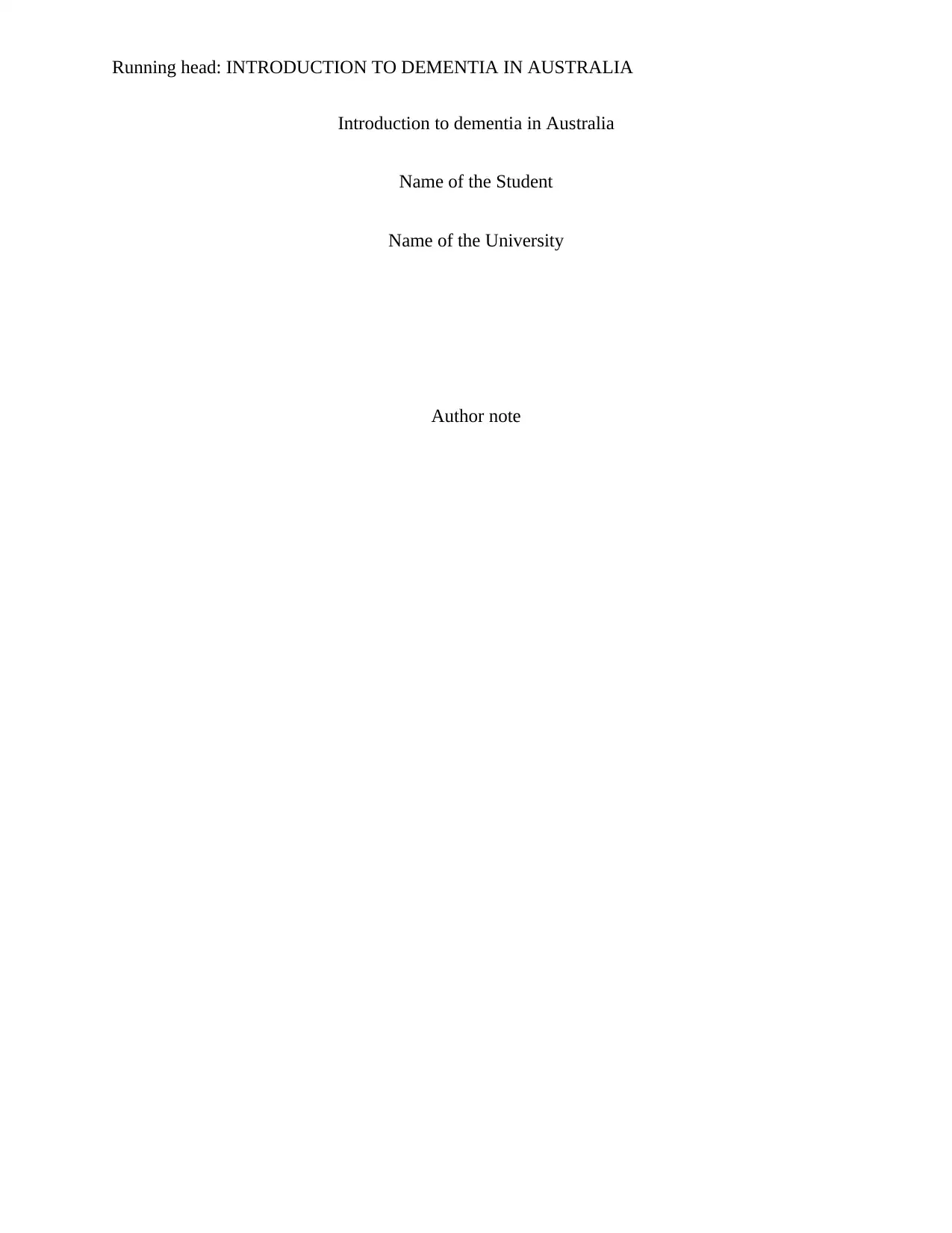
Running head: INTRODUCTION TO DEMENTIA IN AUSTRALIA
Introduction to dementia in Australia
Name of the Student
Name of the University
Author note
Introduction to dementia in Australia
Name of the Student
Name of the University
Author note
Paraphrase This Document
Need a fresh take? Get an instant paraphrase of this document with our AI Paraphraser
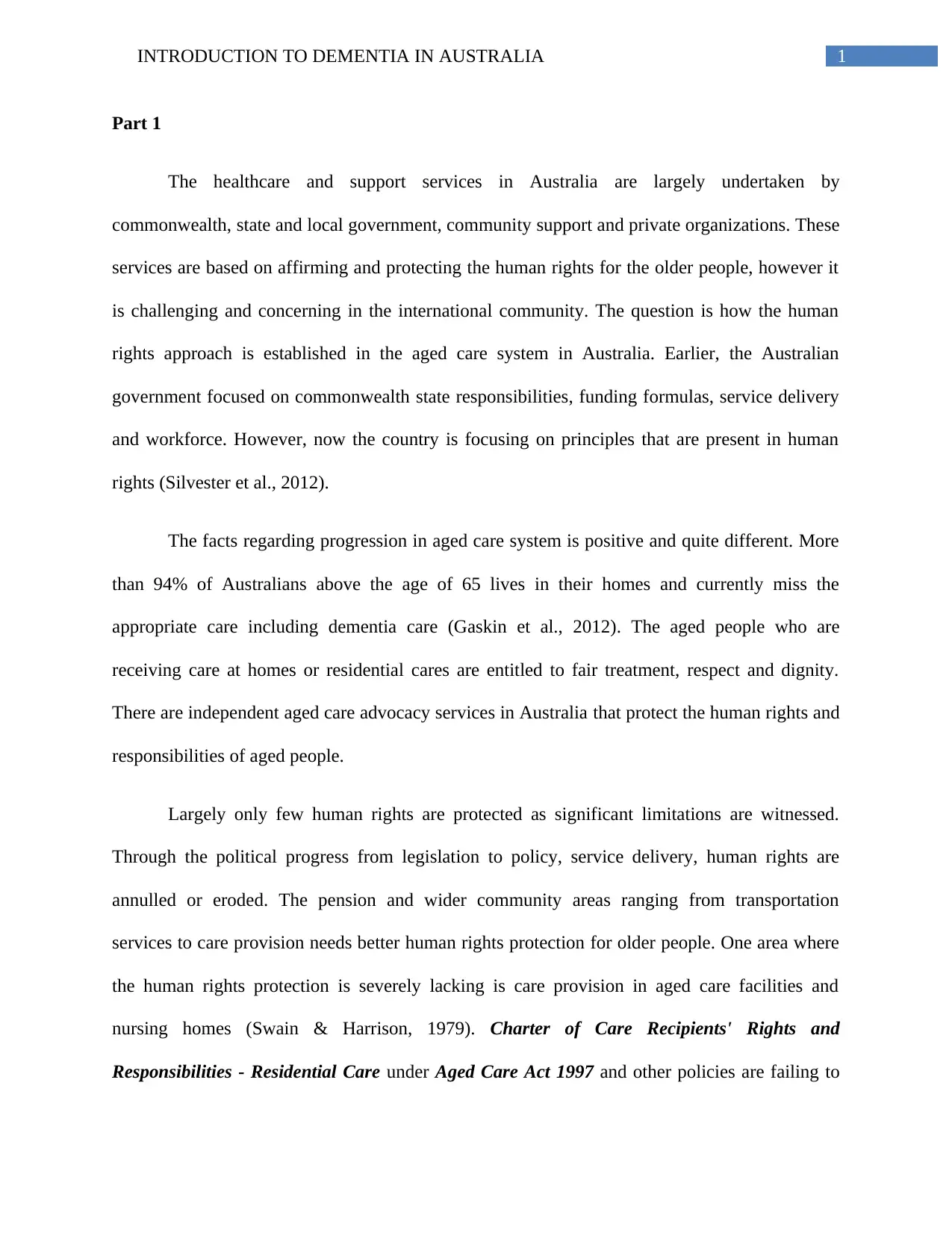
1INTRODUCTION TO DEMENTIA IN AUSTRALIA
Part 1
The healthcare and support services in Australia are largely undertaken by
commonwealth, state and local government, community support and private organizations. These
services are based on affirming and protecting the human rights for the older people, however it
is challenging and concerning in the international community. The question is how the human
rights approach is established in the aged care system in Australia. Earlier, the Australian
government focused on commonwealth state responsibilities, funding formulas, service delivery
and workforce. However, now the country is focusing on principles that are present in human
rights (Silvester et al., 2012).
The facts regarding progression in aged care system is positive and quite different. More
than 94% of Australians above the age of 65 lives in their homes and currently miss the
appropriate care including dementia care (Gaskin et al., 2012). The aged people who are
receiving care at homes or residential cares are entitled to fair treatment, respect and dignity.
There are independent aged care advocacy services in Australia that protect the human rights and
responsibilities of aged people.
Largely only few human rights are protected as significant limitations are witnessed.
Through the political progress from legislation to policy, service delivery, human rights are
annulled or eroded. The pension and wider community areas ranging from transportation
services to care provision needs better human rights protection for older people. One area where
the human rights protection is severely lacking is care provision in aged care facilities and
nursing homes (Swain & Harrison, 1979). Charter of Care Recipients' Rights and
Responsibilities - Residential Care under Aged Care Act 1997 and other policies are failing to
Part 1
The healthcare and support services in Australia are largely undertaken by
commonwealth, state and local government, community support and private organizations. These
services are based on affirming and protecting the human rights for the older people, however it
is challenging and concerning in the international community. The question is how the human
rights approach is established in the aged care system in Australia. Earlier, the Australian
government focused on commonwealth state responsibilities, funding formulas, service delivery
and workforce. However, now the country is focusing on principles that are present in human
rights (Silvester et al., 2012).
The facts regarding progression in aged care system is positive and quite different. More
than 94% of Australians above the age of 65 lives in their homes and currently miss the
appropriate care including dementia care (Gaskin et al., 2012). The aged people who are
receiving care at homes or residential cares are entitled to fair treatment, respect and dignity.
There are independent aged care advocacy services in Australia that protect the human rights and
responsibilities of aged people.
Largely only few human rights are protected as significant limitations are witnessed.
Through the political progress from legislation to policy, service delivery, human rights are
annulled or eroded. The pension and wider community areas ranging from transportation
services to care provision needs better human rights protection for older people. One area where
the human rights protection is severely lacking is care provision in aged care facilities and
nursing homes (Swain & Harrison, 1979). Charter of Care Recipients' Rights and
Responsibilities - Residential Care under Aged Care Act 1997 and other policies are failing to
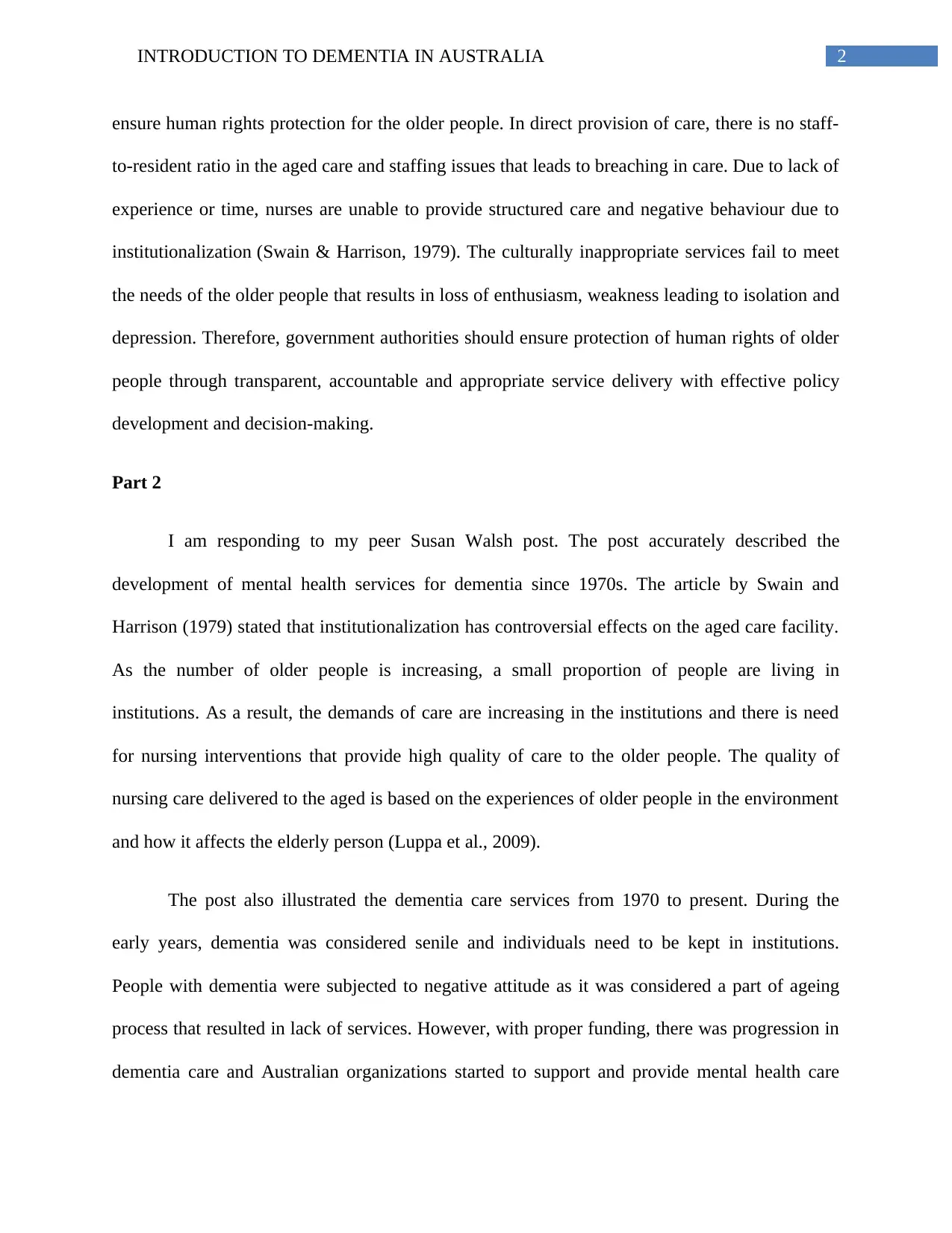
2INTRODUCTION TO DEMENTIA IN AUSTRALIA
ensure human rights protection for the older people. In direct provision of care, there is no staff-
to-resident ratio in the aged care and staffing issues that leads to breaching in care. Due to lack of
experience or time, nurses are unable to provide structured care and negative behaviour due to
institutionalization (Swain & Harrison, 1979). The culturally inappropriate services fail to meet
the needs of the older people that results in loss of enthusiasm, weakness leading to isolation and
depression. Therefore, government authorities should ensure protection of human rights of older
people through transparent, accountable and appropriate service delivery with effective policy
development and decision-making.
Part 2
I am responding to my peer Susan Walsh post. The post accurately described the
development of mental health services for dementia since 1970s. The article by Swain and
Harrison (1979) stated that institutionalization has controversial effects on the aged care facility.
As the number of older people is increasing, a small proportion of people are living in
institutions. As a result, the demands of care are increasing in the institutions and there is need
for nursing interventions that provide high quality of care to the older people. The quality of
nursing care delivered to the aged is based on the experiences of older people in the environment
and how it affects the elderly person (Luppa et al., 2009).
The post also illustrated the dementia care services from 1970 to present. During the
early years, dementia was considered senile and individuals need to be kept in institutions.
People with dementia were subjected to negative attitude as it was considered a part of ageing
process that resulted in lack of services. However, with proper funding, there was progression in
dementia care and Australian organizations started to support and provide mental health care
ensure human rights protection for the older people. In direct provision of care, there is no staff-
to-resident ratio in the aged care and staffing issues that leads to breaching in care. Due to lack of
experience or time, nurses are unable to provide structured care and negative behaviour due to
institutionalization (Swain & Harrison, 1979). The culturally inappropriate services fail to meet
the needs of the older people that results in loss of enthusiasm, weakness leading to isolation and
depression. Therefore, government authorities should ensure protection of human rights of older
people through transparent, accountable and appropriate service delivery with effective policy
development and decision-making.
Part 2
I am responding to my peer Susan Walsh post. The post accurately described the
development of mental health services for dementia since 1970s. The article by Swain and
Harrison (1979) stated that institutionalization has controversial effects on the aged care facility.
As the number of older people is increasing, a small proportion of people are living in
institutions. As a result, the demands of care are increasing in the institutions and there is need
for nursing interventions that provide high quality of care to the older people. The quality of
nursing care delivered to the aged is based on the experiences of older people in the environment
and how it affects the elderly person (Luppa et al., 2009).
The post also illustrated the dementia care services from 1970 to present. During the
early years, dementia was considered senile and individuals need to be kept in institutions.
People with dementia were subjected to negative attitude as it was considered a part of ageing
process that resulted in lack of services. However, with proper funding, there was progression in
dementia care and Australian organizations started to support and provide mental health care
⊘ This is a preview!⊘
Do you want full access?
Subscribe today to unlock all pages.

Trusted by 1+ million students worldwide
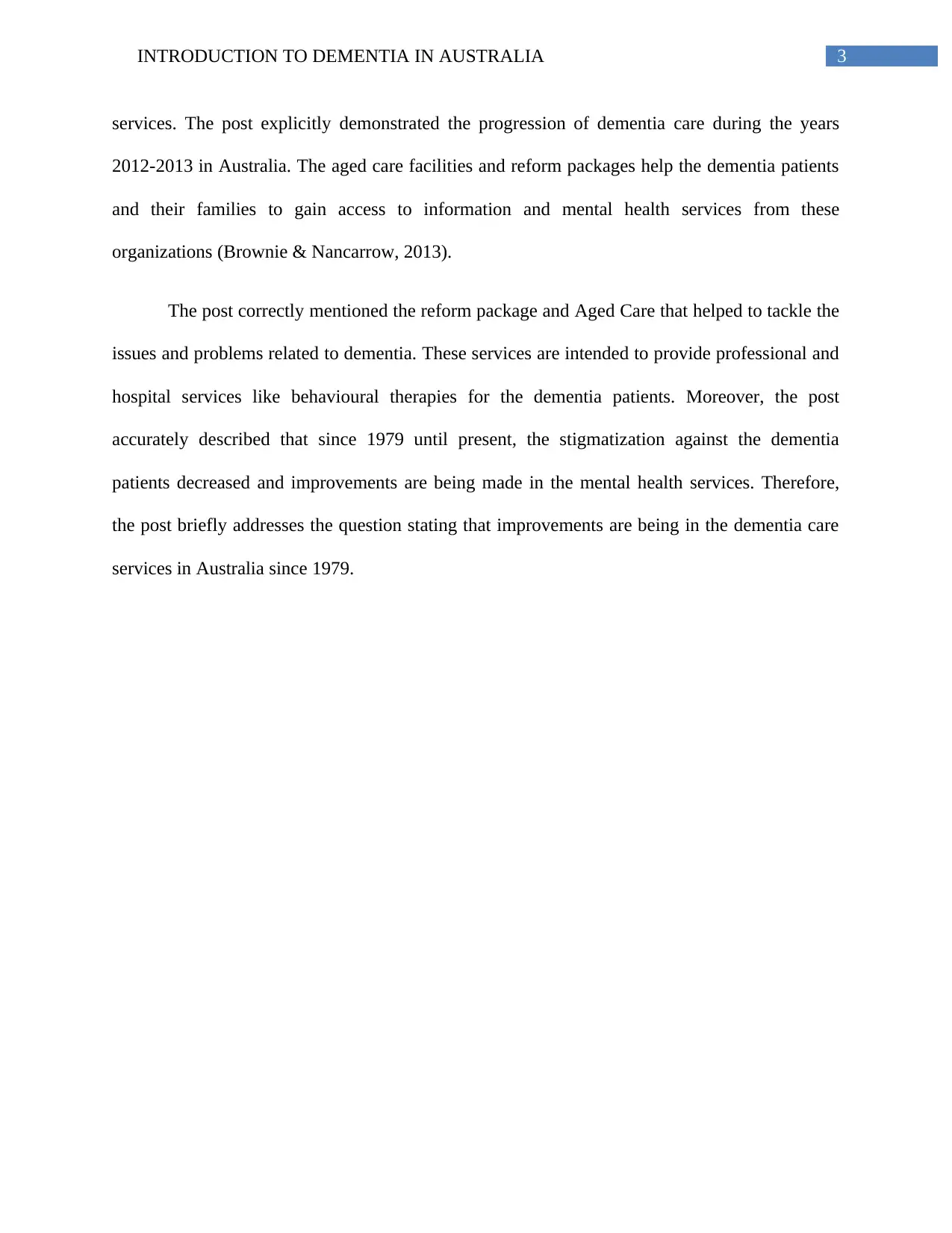
3INTRODUCTION TO DEMENTIA IN AUSTRALIA
services. The post explicitly demonstrated the progression of dementia care during the years
2012-2013 in Australia. The aged care facilities and reform packages help the dementia patients
and their families to gain access to information and mental health services from these
organizations (Brownie & Nancarrow, 2013).
The post correctly mentioned the reform package and Aged Care that helped to tackle the
issues and problems related to dementia. These services are intended to provide professional and
hospital services like behavioural therapies for the dementia patients. Moreover, the post
accurately described that since 1979 until present, the stigmatization against the dementia
patients decreased and improvements are being made in the mental health services. Therefore,
the post briefly addresses the question stating that improvements are being in the dementia care
services in Australia since 1979.
services. The post explicitly demonstrated the progression of dementia care during the years
2012-2013 in Australia. The aged care facilities and reform packages help the dementia patients
and their families to gain access to information and mental health services from these
organizations (Brownie & Nancarrow, 2013).
The post correctly mentioned the reform package and Aged Care that helped to tackle the
issues and problems related to dementia. These services are intended to provide professional and
hospital services like behavioural therapies for the dementia patients. Moreover, the post
accurately described that since 1979 until present, the stigmatization against the dementia
patients decreased and improvements are being made in the mental health services. Therefore,
the post briefly addresses the question stating that improvements are being in the dementia care
services in Australia since 1979.
Paraphrase This Document
Need a fresh take? Get an instant paraphrase of this document with our AI Paraphraser
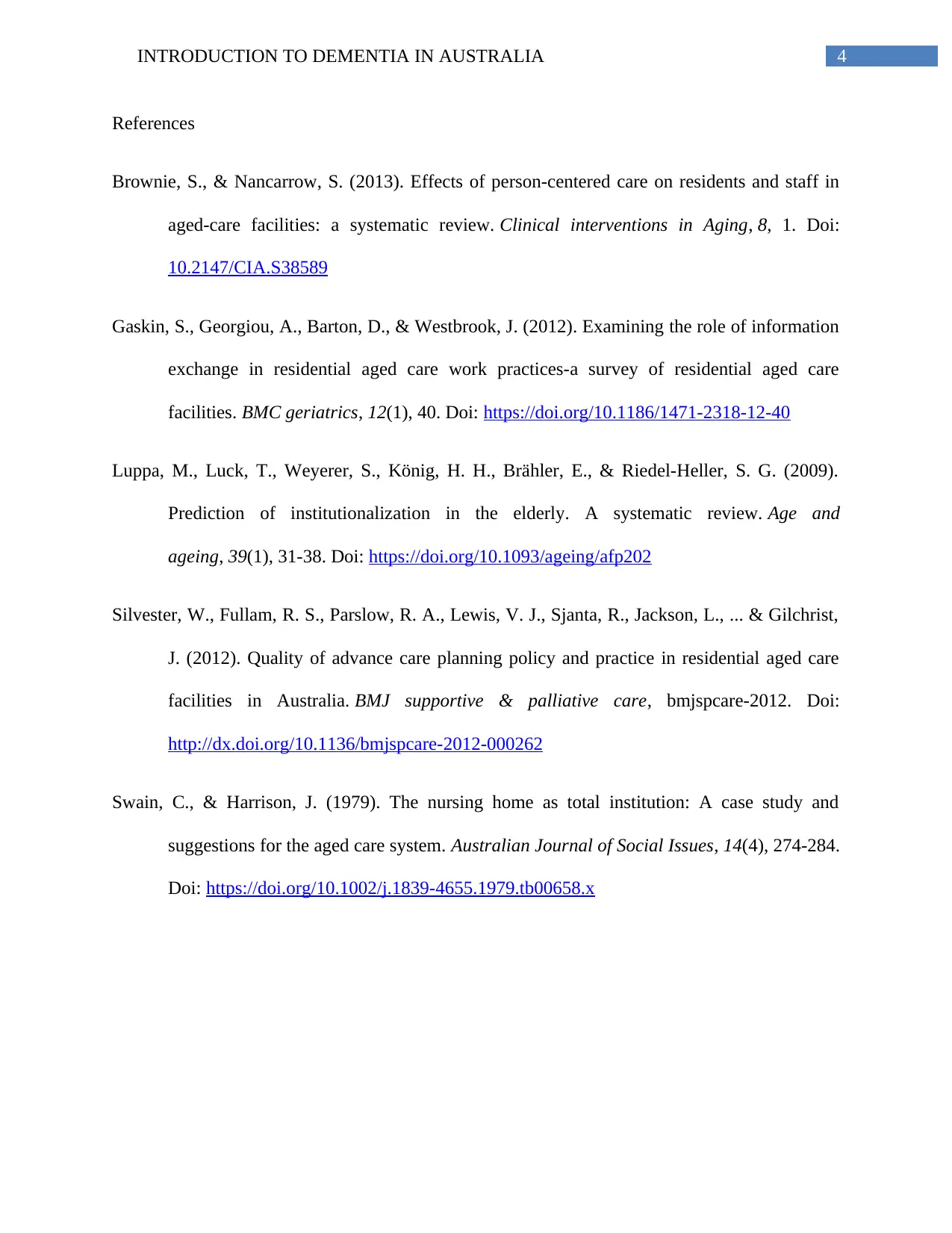
4INTRODUCTION TO DEMENTIA IN AUSTRALIA
References
Brownie, S., & Nancarrow, S. (2013). Effects of person-centered care on residents and staff in
aged-care facilities: a systematic review. Clinical interventions in Aging, 8, 1. Doi:
10.2147/CIA.S38589
Gaskin, S., Georgiou, A., Barton, D., & Westbrook, J. (2012). Examining the role of information
exchange in residential aged care work practices-a survey of residential aged care
facilities. BMC geriatrics, 12(1), 40. Doi: https://doi.org/10.1186/1471-2318-12-40
Luppa, M., Luck, T., Weyerer, S., König, H. H., Brähler, E., & Riedel-Heller, S. G. (2009).
Prediction of institutionalization in the elderly. A systematic review. Age and
ageing, 39(1), 31-38. Doi: https://doi.org/10.1093/ageing/afp202
Silvester, W., Fullam, R. S., Parslow, R. A., Lewis, V. J., Sjanta, R., Jackson, L., ... & Gilchrist,
J. (2012). Quality of advance care planning policy and practice in residential aged care
facilities in Australia. BMJ supportive & palliative care, bmjspcare-2012. Doi:
http://dx.doi.org/10.1136/bmjspcare-2012-000262
Swain, C., & Harrison, J. (1979). The nursing home as total institution: A case study and
suggestions for the aged care system. Australian Journal of Social Issues, 14(4), 274-284.
Doi: https://doi.org/10.1002/j.1839-4655.1979.tb00658.x
References
Brownie, S., & Nancarrow, S. (2013). Effects of person-centered care on residents and staff in
aged-care facilities: a systematic review. Clinical interventions in Aging, 8, 1. Doi:
10.2147/CIA.S38589
Gaskin, S., Georgiou, A., Barton, D., & Westbrook, J. (2012). Examining the role of information
exchange in residential aged care work practices-a survey of residential aged care
facilities. BMC geriatrics, 12(1), 40. Doi: https://doi.org/10.1186/1471-2318-12-40
Luppa, M., Luck, T., Weyerer, S., König, H. H., Brähler, E., & Riedel-Heller, S. G. (2009).
Prediction of institutionalization in the elderly. A systematic review. Age and
ageing, 39(1), 31-38. Doi: https://doi.org/10.1093/ageing/afp202
Silvester, W., Fullam, R. S., Parslow, R. A., Lewis, V. J., Sjanta, R., Jackson, L., ... & Gilchrist,
J. (2012). Quality of advance care planning policy and practice in residential aged care
facilities in Australia. BMJ supportive & palliative care, bmjspcare-2012. Doi:
http://dx.doi.org/10.1136/bmjspcare-2012-000262
Swain, C., & Harrison, J. (1979). The nursing home as total institution: A case study and
suggestions for the aged care system. Australian Journal of Social Issues, 14(4), 274-284.
Doi: https://doi.org/10.1002/j.1839-4655.1979.tb00658.x
1 out of 5
Related Documents
Your All-in-One AI-Powered Toolkit for Academic Success.
+13062052269
info@desklib.com
Available 24*7 on WhatsApp / Email
![[object Object]](/_next/static/media/star-bottom.7253800d.svg)
Unlock your academic potential
Copyright © 2020–2025 A2Z Services. All Rights Reserved. Developed and managed by ZUCOL.

![Essay: Health and Socio-Political Issues in Aged Care - [Course Name]](/_next/image/?url=https%3A%2F%2Fdesklib.com%2Fmedia%2Fimages%2Fvs%2F0bb57a769db247618d0c7eb523e0850c.jpg&w=256&q=75)


